| Annals of Burns and Fire Disasters - vol. X - n. 4 - December 1997
FIRE DISASTER IN A MOTORWAY TUNNEL
Masellis M., laia A., Sferrazza G., Pirillo E.,
D'Arpa N., Cucchiara P., Sucameli M., Napoli B., Alessandro G., Giairni S.
Divisione Chirurgia Plastica e Terapia delle
Ustioni, Ospedale Civico, Palermo, ltaly
SUMMARY. On 18
March 1996, in a tunnel along the Palermo-Punta Raisi motorway (Italy), a tank-truck
carrying 2500 litres of liquid petroleurn gas (LPG) was involved in an accident. The truck
was hit by a coach, which ripped off the top of the coach, provoking the escape of gas,
which caught fire within seconds. The flames heated the LPG still in the tank, causing a
BLEVE(boiling liquid expanding vapour explosion). At the moment of the accident there were
22 cars and a minibus in the tunnel, besides the coach, with a total of 50 persons. The
delay between the ignition of the gas and the explosion enabled numerous passengers to
escape. However, five people were burned to death and twenty were severely injured. Ten
people presented minor burns or other traumas. The following aspects are analysed: the
dynamic of the accident, the dynamic of the rescue operations, the management of the
severely injured patients treated at the Palermo Burns Centre, the psychological reaction
of the population, relatives and injured persons, the evolution of the pathologies, and
the medical and surgical treatment. The Palermo tunnel disaster, with its terrible
dynamic, confirms the thesis that the only way to counteract the impossibility of
predicting this type of accident is through the coordinated response of rescue aid at all
levels, from the general population to physicians, nurses, volunteer groups, Civil
Defence, police, etc., who must all be adequately trained in appropriate education
campaigns to prevent fire disasters. This accident, the first case described of a BLEVE in
a closed and restricted environment, can provide material for indications and suggestions
for the formulation of research hypotheses, operative proposals and teaching
possibilities, with a view to realizing an ever higher level of disaster preparedness.
Introduction
On 18 March 1996, on the motorway between Palermo and Punta Raisi Airport, there was
an accident in a tunnel in which a tank-truck carrying liquid petroleum gas (LPG) caught
fire and exploded, leading to a fire disaster that caused the death of five persons and
burn injuries in 34 other persons.
The scene of the disaster
The tunnel, 148 metres long, carries one-way traffic in the direction Punta Raisi-Palermo.
At the midway point there is a bend to the right of about 25'. The road surface in the
tunnel slopes from left to right to assist the drainage of rainwater. At a distance of
about 100 metres from the entrance of the tunnel there are signs imposing an 80 kph speed
limit. The tunnel is not provided with illuminated warning signals. Near the entrance to
the tunnel there are signs advising drivers of the presence of radar speed-check devices.
Parallel to the tunnel is another one the same length carrying traffic in the opposite
direction (Fig.1). The two tunnels are connected by a passageway measuring 5 x 10
m. The tunnel is 10 km from Palermo and 7 km from Punta Raisi Airport (Fig.2). The
nearest motorway exits are Carini, Capaci, and Isola delle Femmine. The nearest towns with
hospitals are Carini (4 km), with a small hospital, and Palermo (10 km), with a Burns
Centre and the Villa Sofia and G. Cervello Emergency Hospitals.
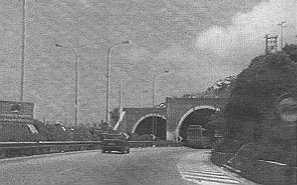 |
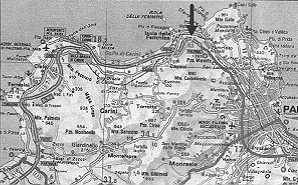 |
Fig.1 -
The two parallel morway tunnels
involved in the fire disaster. Entry from Punta
Raisi. The fire was in the right tunnel. |
Fig.2 -
Map showing distances between Palermo,
Punta Raisi, and nearest small towns |
|
Every day approximately 40,000 vehicles
use the motorway each way, with peak traffic in the summer period and at certain times of
day (up to 10,000 vehicles per hour). At the time of the disaster (2.30 p.m.), traffic was
fairly busy as many people were returning from the country into town, and vice versa. In
particular, there were several school buses, and a number of charter flights had just
landed at the airport.
Dynamics of the disaster
It was raining on 18 March 1996. At
about 2.20 p.m., either because the road was wet or because of excessive speed, a car
skidded, hit the guard-rail, and turned over, blocking the lane. Other vehicles were
following, including a minibus. There was a massive pileup and the whole tunnel was
blocked (involving sixteen vehicles in all).
At the same moment a tank-truck approached, carrying a load of 2,500 litres of LPG. The
driver succeeded in stopping the truck without crashing into the stationary vehicles. He
immediately activated his flashing amber light to warn following traffic of the danger.
However, a Mediterranean Tours Coach with fourteen persons on board was not far behind.
The driver was unable to stop the coach, which skidded to the left' and crashed violently
into the tank-truck. Immediately behind the coach were four other vehicles, which crashed
into the coach and into each other. At this moment nineteen cars, a minibus, the coach and
the tank-truck were stuck in the tunnel, with some 50 persons on board (Fig. 3).
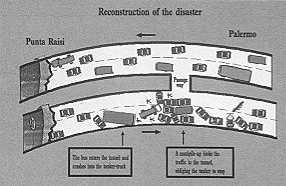 |
Fig.
3 - Reconstruction of the disaster in the tunnel |
|
The impact between the coach and the
tank-truck was violent. As a result there was a gas leak from the tanktruck due to damage
to the upper part, which had been ripped open (eye-witnesses remember a plume of white
vapour above the tank, and when the various parts of the tank were reassembled it was
found that the upper part was ripped open).
After a few seconds, according to witnesses' reports, there was a first explosion.
Probably the cloud of gas ignited as a result of a spark from a car motor that was still
running or because of contact with a hot engine or with gas mixed with air. Witnesses
remember being invested with a hot blast that caused a burning pain in exposed parts of
the body, without causing much damage to the vehicles, where most of the people were.
The fire mainly involved the front part of the coach, which caught fire. The driver later
reported that he saw a sudden large flash and black smoke outside the coach, at which
point he shouted to the passengers to move to the back of the coach. He was unable to open
the passenger doors. Someone broke open the rear window, through which passengers escaped.
The tunnel was dark and full of smoke, and it was not noticed that five persons had been
left in the coach, possibly overcome by the fumes.
The fire continued to feed the burning gas escaping from the tank. After 6-7 min, when
everybody had escaped from the tunnel (except for the four persons left in the coach,
later found completely burned, and one person who was discovered between the coach and the
tank~truck), there was a tremendous explosion with violent flames and black smoke, and
shock waves at the exits of the tunnel, and also of the adjacent tunnel (Fig. 4).
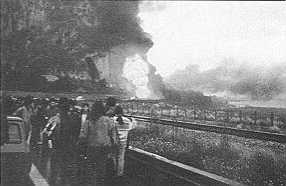 |
Fig. 4 - The
violent fire in the tunnel after the BLEVE |
|
The second explosion was presumably a case
of BLEVE (boiling liquid expanding vapour explosion) caused by the direct action of heat
on the tank. This would then have led to the boiling of the liquid gas, the formation of
more gas, an increase in pressure, and further ripping open of the tank, with the possible
leakage of LPG still in liquid state, which immediately evaporated." The cloud of gas
and the drops of LPG caught fire immediately, causing the explosion of the tank (Figs.
5).
How does a BLEVE occur?
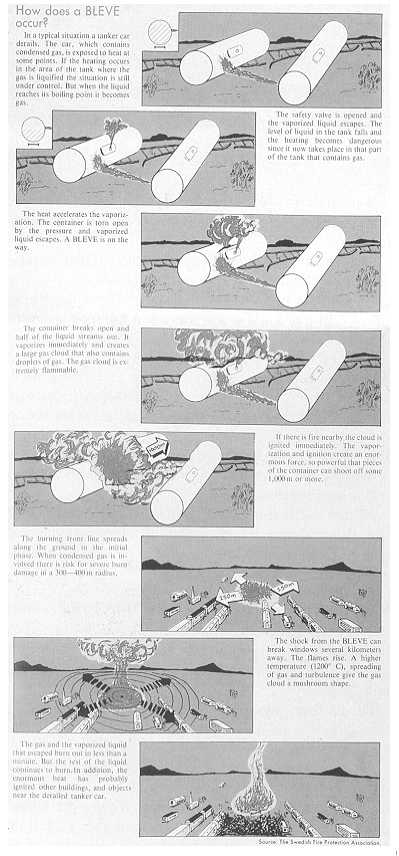
|
Fig. 5 -
Schematic representation of a BLEVE
(from "First", a journal of the Skandia International Insurance
Corporation). |
|
Subsequent examination of the four pieces
of the tank found after the disaster confirmed that the explosion occurred inside the
tank, in the central part (Figs 7a, b, c). The fire then spread all over the tunnel
and was finally extinguished by the fire brigade after two hours (8a, b, c, d).
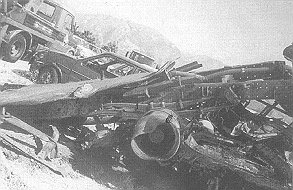 |
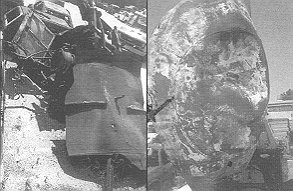 |
| Fig. 7a -
The tank-truck after explosion. |
Fig. 7b -
Pieces of the tank-truck after explosion. |
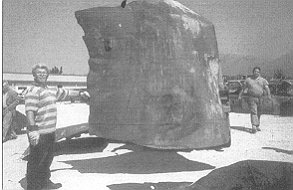 |
Fig. 7c -
Pieces of the tank-truck after explosion. |
|
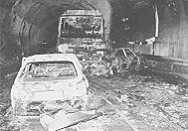 |
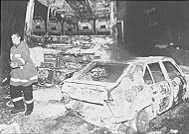 |
| Fig. 8a - Aspect
of tunnel after fire. |
Fig. 8b -
Aspect of tunnel after fire. |
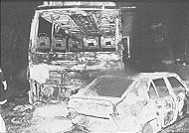 |
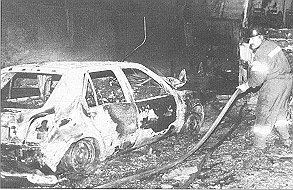 |
| Fig. 8c -
Aspect of tunnel after fire. |
Fig. 8d
- Aspect of tunnel after fire. |
|
The BLEVE lasted for 5-6 seconds, reaching
a temperature of over 1000 °C. Witnesses remember that after the collision between the
cars a fire started in one of the vehicles (the tank-truck driver said that he tried to
extinguish it with a fire extinguisher) and that there was an explosion a few seconds
after the crash between the coach and the tank-truck (first explosion). Six or seven
minutes later, when the survivors had left the tunnel, there was a violent explosion, with
great flames at the exits of the tunnel and a sharp shock wave and smoke, also in the
other tunnel (BLEVE).
Situation at the Burns Centre at the
moment of the disaster; emergency preparedness
The Palermo Burns Centre has twelve beds
for intensive care (intensive area, IA), plus eighteen beds for patients with less serious
burns, in the recovery stage, or having reconstructive surgery (post-intensive area, PIA),
adjacent to an emergency Operating Room (Fig. 6). The Centre is on the second floor
of a new building, of which the first floor is occupied by the Plastic Surgery section (50
beds). The intensive care beds are located, in pairs, in six rooms, each with its own
autonomous climatization plant.
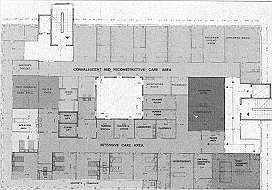
|
Fig. 6 -
Plan of the Palermo Burns Centre. |
|
Each patient is monitored visually from a
nurse-station by means of a TV circuit. Monitoring of heart function, pressure,
respiration and weight is also centralized and controlled from the nurse-station. All data
can be computerized.
The intensive care section is surrounded by an external corridor from which visitors can
view the patients through a window and speak by means of an intercom system. This section
is self-sufficient - it has its own laboratory for chemical analyses and its own pharmacy.
It is in direct contact with the operating theatre complex by way of a stretcher lift.
The eighteen PIA beds occupy the other half of the floor.
The third floor is taken up by the operating theatre complex for the whole Department.
There is also a Modumed operating room with a passe-malade reserved for the surgical
treatment of burns, and there are two other operating rooms for the activity of the
Plastic Surgery Sections.
On the ground floor is the Emergency section of the Department, with two operating rooms
for emergency surgery, out~patient rooms, offices and the library. The rehabilitation
rooms are in the basement.
With its up-to-date technology, the Palermo Burns Centre is generally recognized as one of
the the most modern in Italy.
At 2.40 p.m. the Burns Centre was alerted to the possible arrival of a number of burn
patients (Table I).
| 0 min |
|
14.15
14.25
14.26
14.30
14.32
14.36
14.37
14.40 |
|
Beginning of maxi pile-up
Coach crashes into tank-truck
First explosion and ignition of cloud of gas. 32 burned and injured patients
Front part of the coach catches fire
Police patrol arrives and warns headquarters
BLEVE
Fire brigade, police, burns centre, other hospitals and emergency services alerted
The less seriously injured are taken by police car and private vehicles to nearest
hospitals (Carim - 4 km, Cervello - 7 km) |
| 30 min |
|
14.45
14.50
14.55 |
|
Three more patrol cars arrive and take injured
persons to nearest hospitals
Two ambulances arrive
Ten more ambulances arrive, plus fire brigade
First ambulance departs for Palermo Burns Centre, followed by other anibulances
|
| 1 h |
|
15.40
15.45
15.50
15.55 |
|
First ambulance arrives at
Burns Centre with two patients
Two more patients arrive at Burns Centre
Seven more patients arrive at Burns Centre
Five more patients arrive at Burns Centre |
| 2 h |
|
16.30
17.00 |
|
Two more patients arrive and are discharged
after medication
Two more patients arrive and are discharged after medication |
|
|
|
18.15 |
|
Two more burn patients,
involved in another accident
(gas cylinder explosion), arrive |
|
|
19,00 |
|
Two more burn patients, injured
in a bonfire accident, arrive |
|
In all,
twenty-four patients arrived in four hours, of whom twenty were hospitalized.
Of these twenty patients, sixteen were injured in the tunnel disaster. |
|
Table
I - Chronological tinie sequence of the disaster and rescue efforts |
|
As soon as news of the disaster reached
the Burns Centre (2.50 p.m.), the emergency plan for such an event immediately became
operative. At that particular moment there were three physicians on duty present in the
Department, plus another physician on call in the afternoon and evening. The Chief of the
Department was immediately warned, and six other physicians were put on pre-alarm status.
Eight IA beds were made available, as well as three PIA beds. The head nurses in the IA
and PIA sections were warned and the nursing teams in the two sections were reinforced.
All the sterile linen in the Department was transferred to the Burns Centre, together with
all other material that might be useful in handling the arrival of a massive numher of
patients.
The hospital pharmacy was instructed to send quantities of Ringer's lactate, acetate and
PPS. The central Emergency Department of the hospital was instructed to send a physician
to carry out the necessary procedures for admission of the patients and to perform
anti-tetanus prophylaxis.
Of the four physicians present, two remained in the Emergency rooms on the ground floor
and two in the Burns Centre.
The first two patients arrived at 3.40 p.m. (50% and 15% burned BSA, respectively). Both
had burns in the face, hands and other parts of the body. They were immediately taken to
the Burns Centre Emergency section. Both said they had inhaled hot air and smoke. The
patients were examined to check percentage BSA and the degree of their burns. Infusion
treatment and medical therapy were initiated immediately. The patients were admitted to
IA.
By 5.30 p.m. all sixteen patients had been monitored and subjected to lab tests and thorax
radiography (Tables II, III)
| Male |
11 |
| Female |
5 |
| Age (yr) |
12-40 |
| Part. thickness |
5 |
| Full thickness |
11 |
| BSA % |
1 = 50% |
1 = 35% |
2 = 25% |
1 = 15% |
1 = 10% |
| All patients declared
they had inhaled smoke and hot air |
|
Table
II - Patients admitted to Burns Centre |
|
N. Pat. |
% BSA |
N. Surg. oper. |
N. CEA graph. |
Hospitaliz. (days) |
5 |
10 |
- |
- |
10.2 |
4 |
10 |
1 |
- |
29.5 |
2 |
10 |
2 |
- |
27.0 |
1 |
15 |
1 |
- |
32.0 |
2 |
20 |
2 |
- |
42.0 |
1 |
35 |
3 |
1 |
73.0 |
1 |
50 |
3 |
1 |
80.0 |
|
Table
III - Patients treated at Burns Centre |
|
Discussion
On the basis of an analysis of the factors
that combined to cause the accident, i.e. the dynamics of the initial crash (maxi
pile-up), the type of explosion (BLEVE), the place where the accident occurred (tunnel),
the number of persons initially involved (over 50), and the rescue operations (immediate
on-the-spot assistance), the following considerations can be made:
the maxi pile-up in the tunnel blocked a
considerable number of vehicles (22) and persons (over 50) in a closed and poorly
illuminated environment
all the passengers remained either near
or inside their vehicles waiting for the traffic to move again. Nobody thought of getting
out of the tunnel because it was raining. Nobody attempted to stop following traffic
about half-way along the line of
vehicles blocked in the tunnel there was a tank-truck carrying 2,500 litres of LPG
people became aware of the imminent risk
only after the first explosion, with the ignition of the cloud of gas and the sight of
flames investing the upper part of the coach
the ignition of the gas, which all
witnesses described as a rapid gust of very hot wind, caused burns in exposed parts of the
body (face and hands) in all persons (fourteen) some distance from the fire itself,
without causing any damage to vehicles. Fortunately, as the day was cold and wet, people
were wearing heavy clothing (Figs 9a, b, c, d)
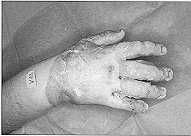 |
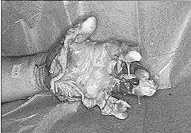 |
| Fig.
9a - Partial- and full-thickness burns |
Fig.
9b - Partial- and full-thickness burns. |
|
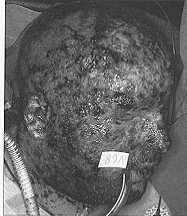 |
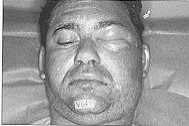 |
| Fig.
9c - Partial- and full-thickness burns. |
Fig.
9d - Partial- and full-thickness burns. |
|
the two most seriously burned persons
were the drivers of the coach and the tank-truck, who were very near the fire. The
coach-driver was the last person to leave the vehicle, having tried first to help the
passengers; the tank-truck driver, having at first attempted to stop the traffic, then saw
the coach approaching and skidding, at which point he moved off towards the exit, but fell
down with his clothes aflame
after the first explosion everybody had
enough time to escape from the tunnel through one of the two exits, at a maximum distance
of some 70 metres from the centre of the tunnel
the BLEVE, in all its violence, did not
occur for a further 6-7 minutes (all reports agree on this), and the physical damage
testifies to its effects (five bodies were totally carbonized). The damage to the tunnel
was immense. The shock wave sent the smoke through the connecting passageway into the
adjacent tunnel, which was totally blackened. Everything in the tunnel where the BLEVE
occurred was completely destroyed. It should be borne in mind that one kg of liquid gas
produces 500 1 of gas which, mixed with air, becomes highly explosive
the on-the-spot rescue work was
fortuitous but also rapid and effective. A police patrol on duty on the motorway gave the
first alarm by radio to its headquarters and to the emergency medical service, which in
turn alerted the Burns Centre and two other hospitals in Palermo. The emergency services
were also alerted by motorists with mobile phones
the less seriously injured persons were
taken by passing cars to Carini hospital (4 km) and to the nearest hospitals in Palermo.
This accounts for some twelve persons who were medicated and discharged
the general feeling of human sympathy
enabled all the injured persons to use police telephones or mobile phones belonging to
members of the general public in order to contact family and friends
the first four ambulances arrived in
loco after 35 minutes, with ten more after 40-45 minutes. Their arrival was
facilitated by the fact that they were stationed on the city outskirts near the motorway
sixteen patients were taken to the
Palermo Burns Centre. None had infusion therapy during the transfer
the first more serious patients arrived
at the Burns Centre 70 minutes after the accident, and the last more than two hours later.
After 2 hours 30 minutes the seriously injured patients were receiving infusion therapy
and blood tests had been performed
the Burns Centre was able to deal with
the impact of the sudden arrival of this large number of patients thanks to an emergency
plan tested on several occasions and also because of the state of preparedness for
disaster emergencies in all the medical and nursing team.
Conclusion
There can be no doubt that in the fire disaster that
occurred in the Palermo-Punta Raisi motorway tunnel there was a combination of fortuitous
and lucky circumstances and also inadequacies that all together limited the number of
victims.
Such episodes provide material for
indications and suggestions directed at formulating research hypotheses, operative
proposals, and teaching points in order to achieve an
ever better level of disaster preparedness.
The Palermo accident, for example, presents a case of BLEVE in a closed and narrow
environment that could have had catastrophic consequences if the tunnel had been longer
and if the people had not had time to escape.
Another aspect is the prevention of such accidents. Explosions of LPG tanks have caused
various disasters in different parts of the world and an analysis of their dynamics has
led to numerous measures at international level for the regulation of the transport of
this highly dangerous material. However, accidents continue to happen and the usual cause
is a collision. It has been suggested that tanktrucks should be obliged to follow special
reserved routes, but even then, if an accident did occur, the surrounding environment
would still suffer considerable damage. It is absolutely essential that every country
should have its emergency plans for such disasters, and that these plans should be a
driving force to improve the general level of technical and logistic preparedness and also
the preparedness of the public. Also, if these plans are not to remain so much paper, they
must be continuously put to the test in drills, refresher courses and exchanges of
information, involving researchers, physicians, nurses, voluntary organizations, firemen,
the police force and the general public.
RESUME. Le 18 mars
1996, dans un tunnel de l'autoroute Palerme-Punta Raisi (Italie), un accident a
intéressé un camion-cisterne qui transportait 2.500 litres de gaz de pétrole liquéfié
(GPL). Le cisteme a été heurté par un car qui en a déchiré la partie supérieure, en
libérant du gaz qui s'est enflammé après quelques secondes. Les flammes ont surchauffé
le GPL encore dans le citerne et a provoqué un BLEVE (boiling liquid expanding vapour
explosion - explosion de vapeur en expansion de liquide bouillant). Au moment de
l'accident il y avait 22 voitures et un minibus dans le tunnel, outre le car, avec un
numéro total d'environ 50 personnes. Le délai entre l'ignition du gaz et l'explosion a
permis à nombreuses personnes de s'échapper. Malheureusement cinq personnes sont mortes
carbonisées et vingt ont subi de graves brûlures. Dix personnes ont présenté des
brûlures légères ou d'autres traumatismes. Les Auteurs analysent les aspects suivants:
la dynamique de l'accident, la dynamique des opérations de sauvetage, la gestion des
patients graves au Centre de Brûlés de Palerme, les réactions psychologiques de la
population, des parents et des victimes, l'évolution des pathologies, le traitement
médical et chirurgical. Le désastre de Palerme, avec sa terrible dynamique, confirme la
thèse selon laquelle nous pouvons nous opposer à l'impossibilité de prédire ce type
d'accident seulement à travers la réponse coordonnée des équipes de secours à tous
les niveaux, depuis la population en général jusqu'aux médecins, aux infirmiers, aux
groupes des volontaires, à la Défense Civile, à la police, à la force publique etc.,
qui doivent tous être adéquatement préparés à travers une campagne appropriée
d'éducation pour la prévention des désastres d'incendie. U accident décrit, le premier
d'une BLEVE dans un environnement clos et limité, pourra fournir du matériel pour
présenter des indications et des suggestions afin de formuler des hypothèses de
recherches, des propositions opérationnelles et des possibilités didactiques pour
réaliser un niveau toujours supérieur de l'état de préparation pour les désastres.
BIBLIOGRAPHY
- Pugh R.W.: Quantify BLEVE hazards. Chem. Eng. Prog., 87:
66-72, 1991.
- Arturson G.: The Los Alfaques disaster: a boiling-liquid,
expandingvapour explosion. Burns, 7: 233-51, 1981.
- Arturson G.: The tragedy of San Juanico. The most severe
LPG 10. disaster in history. Burns, 13: 87-102, 1987.
- Johansson 0., Wormuth D.W.: BLEVE ! The tragedy of San
Juanico. In: "First", a journal of the Skandia International Insurance
Corporation, Stockholm, Sweden: 2-23, 1985.
- Masellis M.: Management of mass burn casualties in
disasters. Ann.Medit. Burns Club, 1: 155-9, 1988.
- Masellis M.: Thermal agent disaster and fire disaster:
definition, damage assessment and relief operations. In: Masellis M., Gunn S.W.A. (eds),
"The Management of Mass Burn Casualties and Fire Disasters: Proceedings of the First
International Conference on Burns and Fire Disasters". Kluwer Academic Publishers,
Dordrecht/Boston/London: 7-12, 1992.
- Masellis M., Ferrara M.M., Gunn S.W.A.: Immediate
assistance and first aid on the spot in fire disasters. Education of the public and
self-sufficiency training. Ann. Medit. Burns Club, 5: 200-6, 1992.
- Magliacani G.: Mass burns rescue operations: organization
and medicosurgical therapies. Ann. Medit. Burns Club, 2: 199-204, 1989.
- Dioguardi D., Brienza E., Altacera M.: The role of
information sciences in the management of disasters. Ann. Medit Burns Club, 1: 165-7,
1988.
- Mackie D.P., Konig H.M.: Fate of mass burn casualties:
implications for disaster planning. Burns, 16: 203-6, 1990.
- Hemdon D.N.: A survey of primary aid response to the
Bashkir train gas pipeline disaster. Burns, 16: 323-4, 1990.
Masellis M., Di Stefano F., Colletti P.,
Pirillo E.: Mass burns in Sicily? Logistic welfare organization in relation to the
regional Burn Centres and to the operating of military sanitary structures. Riv. Ital.
Chir. Plast., 13: 174-85, 1981.
| This article was received on 15
October 1997. Address correspondence
to: Prof. Michele Masellis
Divisione di Chirurgia Plastica e Terapia delle Ustioni
Ospedale Civico
Via C. Lazzaro, 90127 Palermo, Italy. |
|
















